Chris Pinney's cigar box banjo
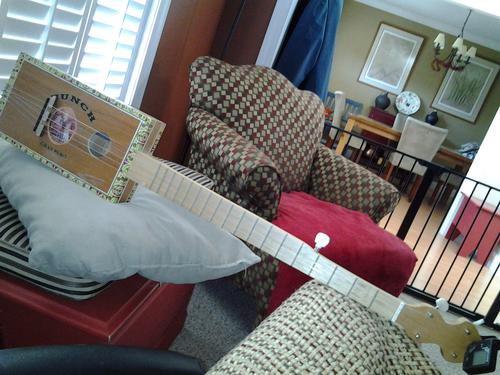 Chris Pinney writes:
Chris Pinney writes:
I have been following your ukulele build over the weeks--well written
presentation: I can only imagine the time it must take to actually write
and figure out the logistics for filming. After seeing the
white-painted screw tailpiece, I thought of my own forays into the
unconventional aspects of luthiery. I build guitars and banjos (and
recently, a sitar). I sell them sometimes, and occasionally give them
away. Many are of available or especially FREE/REPURPOSED materials
such as cigar boxes, gas cans, and wine boxes.
Two years ago, friends
had to threaten me not to embarrass them in restaurants because I kept
asking for and occasionally swiping cheap forks for tail pieces on a
series of cigar box banjos I was building some local musicians and the
father of a friend. I have 16 banjos — some I built, others that are
antiques, but my favourite sound comes from the cigar box banjo of which
I have included pictures.
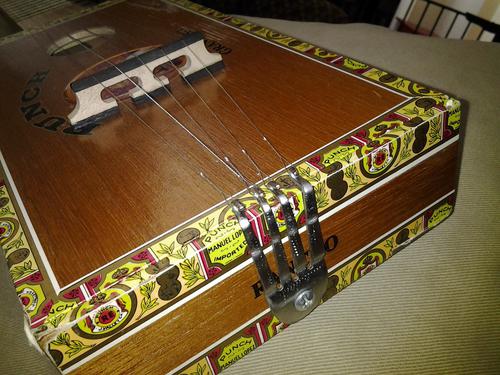 Like all craftsmen, luthiers can sometimes be
an elitist lot. I delight in doing things that "are just not done" and
still achieving the same sound. The sound box for a lute instrument like
a uke or a banjo: vibration and its relationship to bracing are a
factor, but it is hollow body resonance that produces most of the
sound. The cigar box banjo shown is too thick walled to really vibrate
much and it has a stunning resonant sound. Look up Boucher (Baltimore
Md) and Ashburn (Connecticut): they were CARPENTERS who decided to
start making innovative banjos and guitars around the 1830's that are
among the most sought after collectible instruments today.
Like all craftsmen, luthiers can sometimes be
an elitist lot. I delight in doing things that "are just not done" and
still achieving the same sound. The sound box for a lute instrument like
a uke or a banjo: vibration and its relationship to bracing are a
factor, but it is hollow body resonance that produces most of the
sound. The cigar box banjo shown is too thick walled to really vibrate
much and it has a stunning resonant sound. Look up Boucher (Baltimore
Md) and Ashburn (Connecticut): they were CARPENTERS who decided to
start making innovative banjos and guitars around the 1830's that are
among the most sought after collectible instruments today.
This banjo
cost about 20 dollars to make: the tuning machines were $1.85 a piece,
the fret wire was $5, and the box and neck were free. It uses a hard
maple neck from a tree that blew down in a storm. Finish is
spray krylon laquer. Anyway, thanks for the entertaining and
informative work.
Chris Pinney
(the guy with the mobile tablesaw base
from a couple weeks ago)
See also:
Back to my woodworking website

 Like all craftsmen, luthiers can sometimes be
an elitist lot. I delight in doing things that "are just not done" and
still achieving the same sound. The sound box for a lute instrument like
a uke or a banjo: vibration and its relationship to bracing are a
factor, but it is hollow body resonance that produces most of the
sound. The cigar box banjo shown is too thick walled to really vibrate
much and it has a stunning resonant sound. Look up Boucher (Baltimore
Md) and Ashburn (Connecticut): they were CARPENTERS who decided to
start making innovative banjos and guitars around the 1830's that are
among the most sought after collectible instruments today.
Like all craftsmen, luthiers can sometimes be
an elitist lot. I delight in doing things that "are just not done" and
still achieving the same sound. The sound box for a lute instrument like
a uke or a banjo: vibration and its relationship to bracing are a
factor, but it is hollow body resonance that produces most of the
sound. The cigar box banjo shown is too thick walled to really vibrate
much and it has a stunning resonant sound. Look up Boucher (Baltimore
Md) and Ashburn (Connecticut): they were CARPENTERS who decided to
start making innovative banjos and guitars around the 1830's that are
among the most sought after collectible instruments today.
 Chris Pinney writes:
Chris Pinney writes:

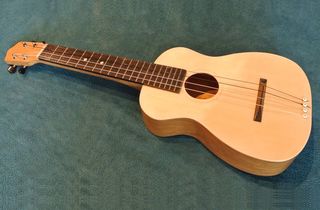 Ukulele build
Ukulele build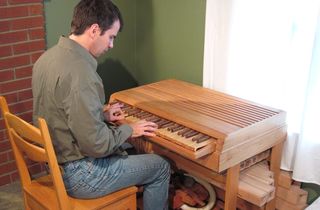 Homemade pipe organ
Homemade pipe organ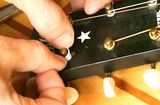 Cheap guitar mods
Cheap guitar mods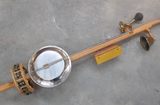
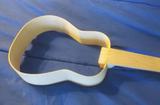
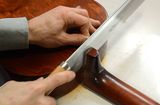 Junk guitar neck reset
Junk guitar neck reset